Separation of Hydrochloric Acid and Oxalic Acid from Rare Earth Oxalic Acid Precipitation Mother Liquor by Electrodialysis
Abstract
:1. Introduction
2. Experiment
2.1. Materials
2.2. Experimental Device and Operation
2.3. Analysis
3. Results and Discussion
3.1. Separation of HCl and OA by Different AEMs
3.2. Effect of OA and HCl Ratio on SAEM Separation
3.2.1. Concentration of Oxalic and Hydrochloric Acid in Each Chamber
3.2.2. Ratio of Transport Number and Selective Transmittance Coefficient
3.3. Separation Effect and Membrane Fouling of SAEM from Real Wastewater
4. Conclusions
Supplementary Materials
Author Contributions
Funding
Data Availability Statement
Conflicts of Interest
References
- Nawab, A.; Yang, X.B.; Honaker, R. Parametric study and speciation analysis of rare earth precipitation using oxalic acid in a chloride solution system. Miner. Eng. 2022, 176, 107352. [Google Scholar] [CrossRef]
- Sadri, F.; Nazari, A.M.; Ghahreman, A. A review on the cracking, baking and leaching processes of rare earth element concentrates. J. Rare Earths 2017, 35, 739–752. [Google Scholar] [CrossRef]
- Demol, J.; Ho, E.; Soldenhoff, K.; Senanayake, G. The sulfuric acid bake and leach route for processing of rare earth ores and concentrates: A review. Hydrometallurgy 2019, 188, 123–139. [Google Scholar] [CrossRef]
- Zhong, Y.; Li, D.; Mao, Z.; Huang, W.; Peng, P.a.; Chen, P.; Mei, J. Kinetics of tetrabromobisphenol A (TBBPA) reactions with H2SO4, HNO3 and HCl: Implication for hydrometallurgy of electronic wastes. J. Hazard. Mater. 2014, 270, 196–201. [Google Scholar] [CrossRef]
- Brandao Pereira, T.C.; dos Santos, K.B.; Lautert-Dutra, W.; Teodoro, L.d.S.; de Almeida, V.O.; Weiler, J.; Homrich Schneider, I.A.; Bogo, M.R. Acid mine drainage (AMD) treatment by neutralization: Evaluation of physical-chemical performance and ecotoxicological effects on zebrafish (Danio rerio) development. Chemosphere 2020, 253, 126665. [Google Scholar] [CrossRef] [PubMed]
- Chen, X.; Chen, T.; Li, J.; Qiu, M.; Fu, K.; Cui, Z.; Fan, Y.; Drioli, E. Ceramic nanofiltration and membrane distillation hybrid membrane processes for the purification and recycling of boric acid from simulative radioactive waste water. J. Membr. Sci. 2019, 579, 294–301. [Google Scholar] [CrossRef]
- Leonzio, G. Recovery of metal sulphates and hydrochloric acid from spent pickling liquors. J. Clean. Prod. 2016, 129, 417–426. [Google Scholar] [CrossRef]
- Li, M.; Yu, X.; Zhou, C.; Yagoub, A.E.A.; Sun, Y.; Yang, H.; Chen, L. Development of back-extraction recyclability of IL-ATPS for the efficient recovery of syringic and caffeic acid. J. Mol. Liq. 2021, 328, 115390. [Google Scholar] [CrossRef]
- Moodley, I.; Sheridan, C.M.; Kappelmeyer, U.; Akcil, A. Environmentally sustainable acid mine drainage remediation: Research developments with a focus on waste/by-products. Miner. Eng. 2018, 126, 207–220. [Google Scholar] [CrossRef]
- Kefeni, K.K.; Msagati, T.A.M.; Mamba, B.B. Acid mine drainage: Prevention, treatment options, and resource recovery: A review. J. Clean. Prod. 2017, 151, 475–493. [Google Scholar] [CrossRef]
- Rezaei, M.; Warsinger, D.M.; Lienhard, V.J.; Duke, M.C.; Matsuura, T.; Samhaber, W.M. Wetting phenomena in membrane distillation: Mechanisms, reversal, and prevention. Water Res 2018, 139, 329–352. [Google Scholar] [CrossRef]
- Yadav, A.; Labhasetwar, P.K.; Shahi, V.K. Membrane distillation crystallization technology for zero liquid discharge and resource recovery: Opportunities, challenges and futuristic perspectives. Sci. Total Environ. 2022, 806, 150692. [Google Scholar] [CrossRef]
- Doornbusch, G.; van der Wal, M.; Tedesco, M.; Post, J.; Nijmeijer, K.; Borneman, Z. Multistage electrodialysis for desalination of natural seawater. Desalination 2021, 505, 114973. [Google Scholar] [CrossRef]
- Wu, I.; Park, R.J.; Ghosh, R.; Kuo, M.-C.; Seifert, S.; Coughlin, E.B.M.; Herring, A.M. Enhancing desalination performance by manipulating block ratios in a polyethylene-based triblock copolymer anion exchange membrane for electrodialysis. J. Membr. Sci. 2022, 647, 120295. [Google Scholar] [CrossRef]
- Mondal, R.; Pal, S.; Bhalani, D.V.; Bhadja, V.; Chatterjee, U.; Jewrajka, S.K. Preparation of polyvinylidene fluoride blend anion exchange membranes via non-solvent induced phase inversion for desalination and fluoride removal. Desalination 2018, 445, 85–94. [Google Scholar] [CrossRef]
- Zhang, Y.; Li, F.; Zhu, M.; Li, J. Preparation and process optimization of monovalent selective cation exchange membrane. Membr. Sci. Technol. 2021, 41, 57–63. [Google Scholar]
- Gurreri, L.; La Cerva, M.; Moreno, J.; Goossens, B.; Trunz, A.; Tamburini, A. Coupling of electromembrane processes with reverse osmosis for seawater desalination: Pilot plant demonstration and testing. Desalination 2022, 526, 115541. [Google Scholar] [CrossRef]
- Strathmann, H. Electrodialysis, a mature technology with a multitude of new applications. Desalination 2010, 264, 268–288. [Google Scholar] [CrossRef]
- Honarparvar, S.; Reible, D. Modeling multicomponent ion transport to investigate selective ion removal in electrodialysis. Environ. Sci. Ecotechnology 2020, 1, 100007. [Google Scholar] [CrossRef]
- Sosa-Fernandez, P.A.; Post, J.W.; Leermakers, A.M.; Rijnaarts, H.H.M.; Bruning, H. Removal of divalent ions from viscous polymer-flooding produced water and seawater via electrodialysis. J. Membr. Sci. 2019, 589, 117251. [Google Scholar] [CrossRef]
- Goel, P.; Bhuvanesh, E.; Mandal, P.; Shahi, V.K.; Bandyopadhyay, A.; Chattopadhyay, S. Di-quaternized graphene oxide based multi-cationic cross-linked monovalent selective anion exchange membrane for electrodialysis. Sep. Purif. Technol. 2021, 276, 119361. [Google Scholar] [CrossRef]
- Zhang, S.; Wang, J.; Shen, F.; Wang, D.; Zhang, S. Efficient removal of metal ions from the ionic liquid aqueous solution by selective electrodialysis. Sep. Purif. Technol. 2022, 295, 121322. [Google Scholar] [CrossRef]
- Hammache, Z.; Bensaadi, S.; Berbar, Y.; Audebrand, N.; Szymczyk, A.; Amara, M. Recovery of rare earth elements from electronic waste by diffusion dialysis. Sep. Purif. Technol. 2021, 254, 117641. [Google Scholar] [CrossRef]
- Bensaadi, S.; Arous, O.; Kerdjoudj, H.; Amara, M. Evaluating molecular weight of PVP on characteristics of CTA membrane dialysis. J. Environ. Chem. Eng. 2016, 4, 1545–1554. [Google Scholar] [CrossRef]
- Lopez, J.; Reig, M.; Gibert, O.; Cortina, J.L. Integration of nanofiltration membranes in recovery options of rare earth elements from acidic mine waters. J. Clean. Prod. 2019, 210, 1249–1260. [Google Scholar] [CrossRef]
- He, F.; Xiang, W.; Chen, S.; Hu, X.; Han, L. Study on selective separation of different valence cations from electrolytic manganese wastewater by electrodialysis. China Environ. Sci. 2021, 10, 142–153. [Google Scholar]
- Aljubran, M.A.; Ali, Z.; Wang, Y.; Alonso, E.; Puspasari, T.; Cherviakouski, K.; Pinnau, I. Highly efficient size-sieving-based removal of arsenic(III) via defect-free interfacially-polymerized polyamide thin-film composite membranes. J. Membr. Sci. 2022, 652, 120477. [Google Scholar] [CrossRef]
- Wang, Q.; Chen, G.Q.; Lin, L.; Li, X.; Kentish, S.E. Purification of organic acids using electrodialysis with bipolar membranes (EDBM) combined with monovalent anion selective membranes. Sep. Purif. Technol. 2021, 279, 119739. [Google Scholar] [CrossRef]
- Golubenkoa, D.V.; Manin, A.D.; Wang, Y.; Xu, T.; Yaroslavtsev, A.B. The way to increase the monovalent ion selectivity of FujiFilm? anion-exchange membranes by cerium phosphate modification for electrodialysis desalination br. Desalination 2022, 531, 115719. [Google Scholar] [CrossRef]
- Hou, J.; Zhang, H.; Simon, G.P.; Wang, H. Polycrystalline Advanced Microporous Framework Membranes for Efficient Separation of Small Molecules and Ions. Adv. Mater. 2020, 32, 1902009. [Google Scholar] [CrossRef]
- Xu, H.; Zhang, L.; Pang, Z.; Wang, Z.; Li, W.; Deng, J. The study on extraction behavior of N1888 P507 and TRPO for heavy rare earths. Miner. Eng. 2022, 176, 107339. [Google Scholar] [CrossRef]
- Batchu, N.K.; Li, Z.; Verbelen, B.; Binnemans, K. Structural effects of neutral organophosphorus extractants on solvent extraction of rare-earth elements from aqueous and non-aqueous nitrate solutions. Sep. Purif. Technol. 2021, 255, 117711. [Google Scholar] [CrossRef]
- Chen, X.; Chen, Q.; Guo, F.; Liu, X.; Li, J.; He, L.; Sun, F.; Zhao, Z. Extraction and separation of W and rare earth from H2SO4-H3PO4 mixed acid leaching liquor of scheelite by primary amine N1923. Sep. Purif. Technol. 2021, 257, 117908. [Google Scholar] [CrossRef]
- Pal, S.; Mondal, R.; Guha, S.; Chatterjee, U.; Jewrajka, S.K. Crosslinked terpolymer anion exchange membranes for selective ion separation and acid recovery. J. Membr. Sci. 2020, 612, 118459. [Google Scholar] [CrossRef]
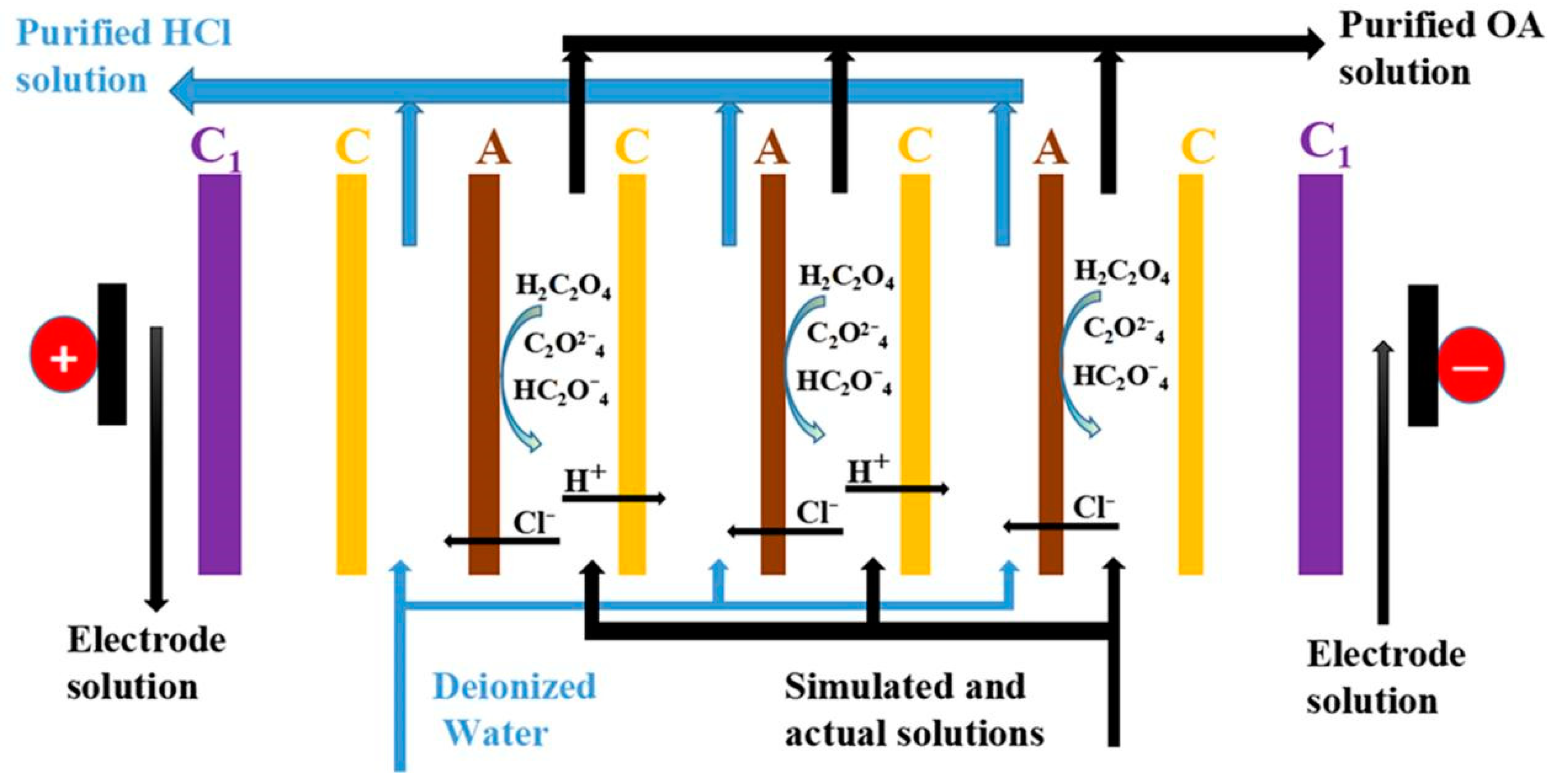
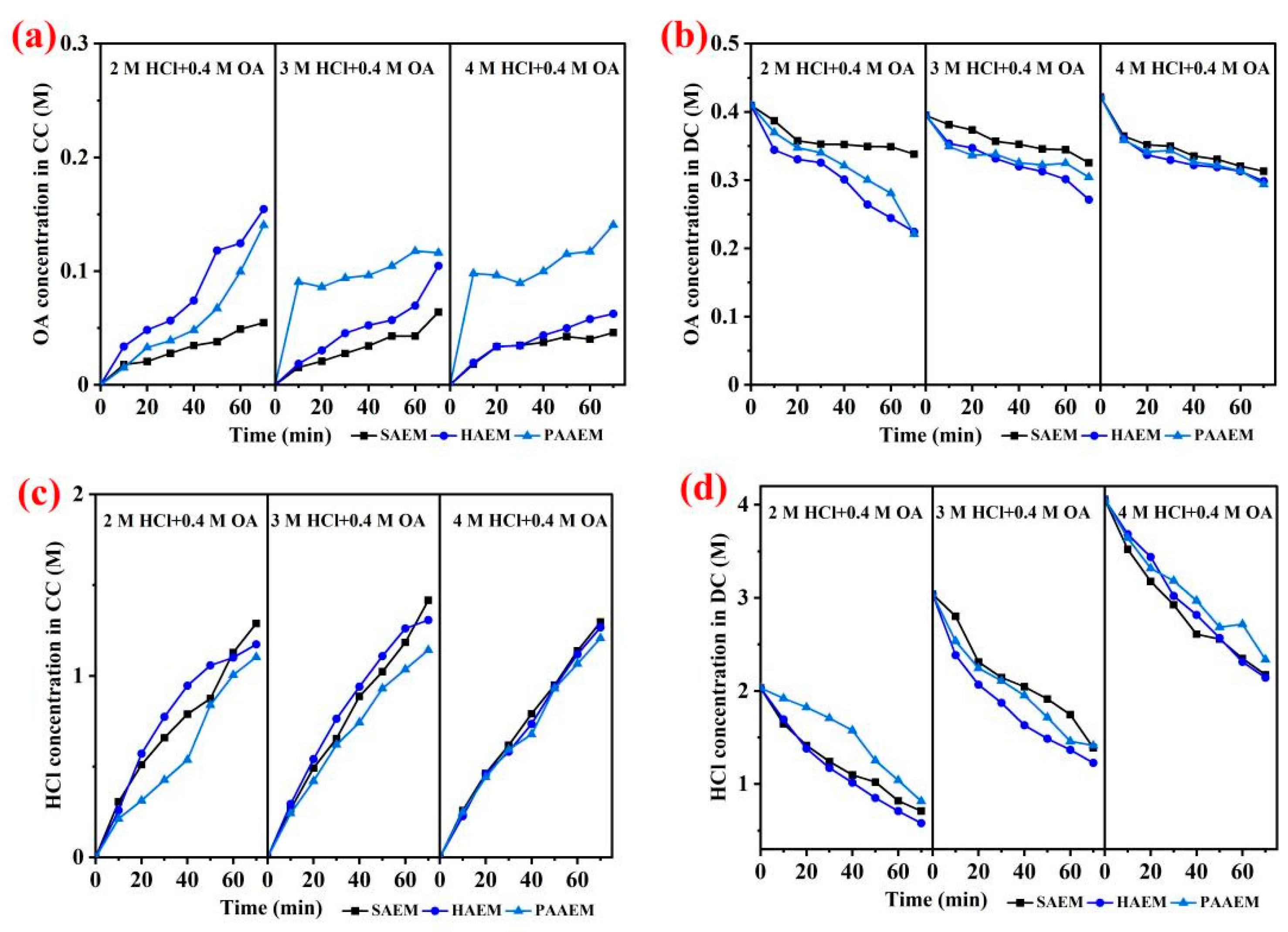
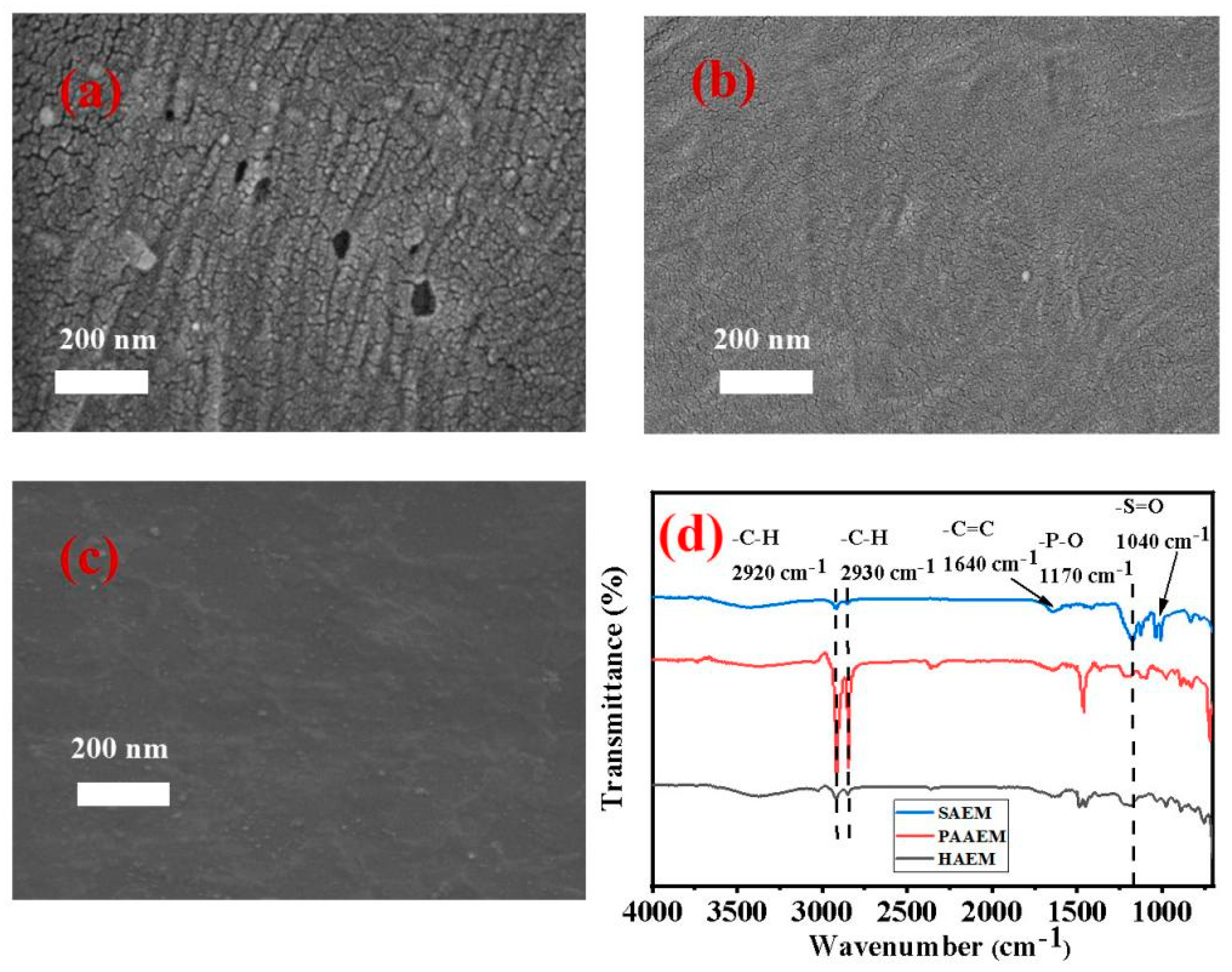
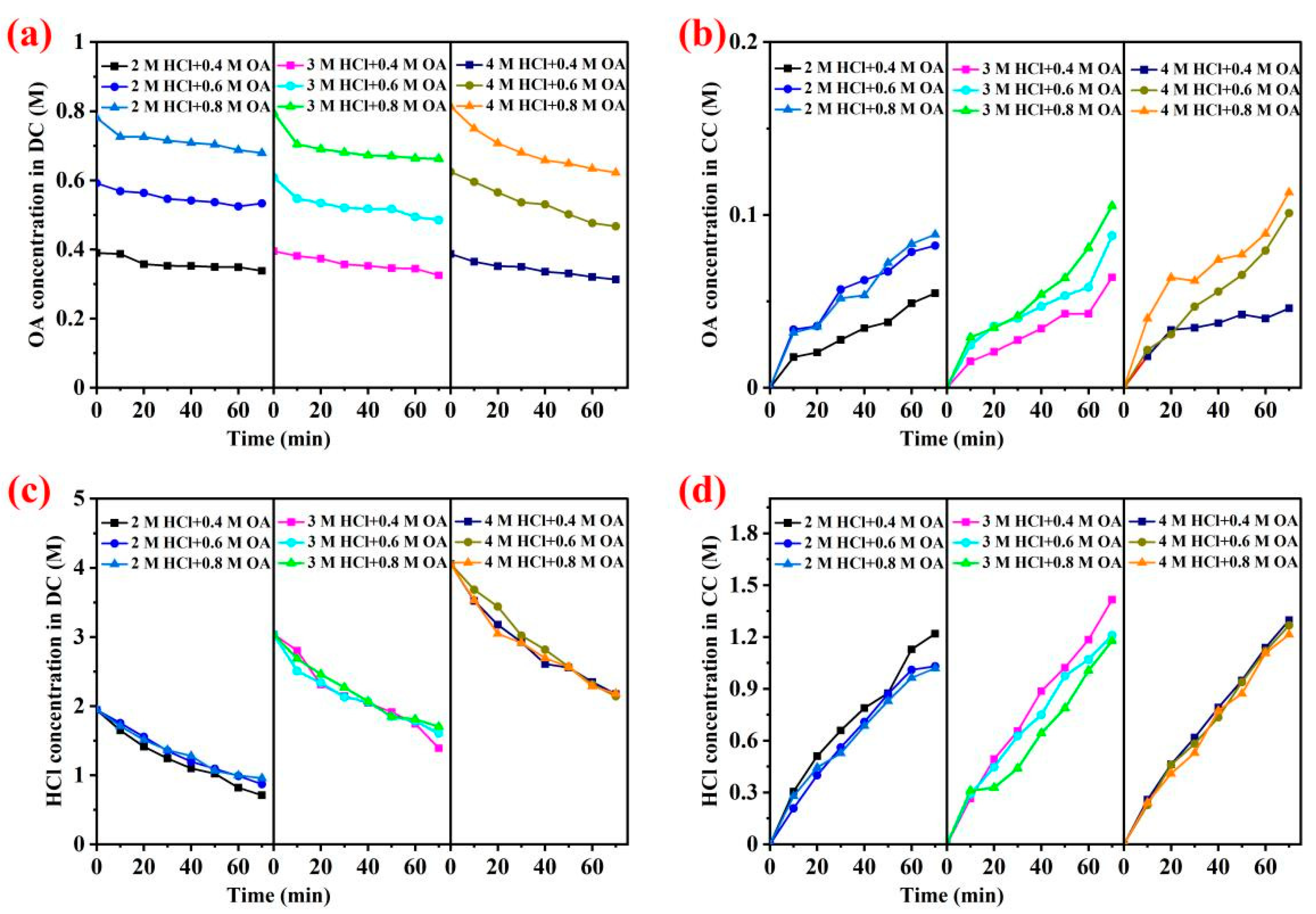

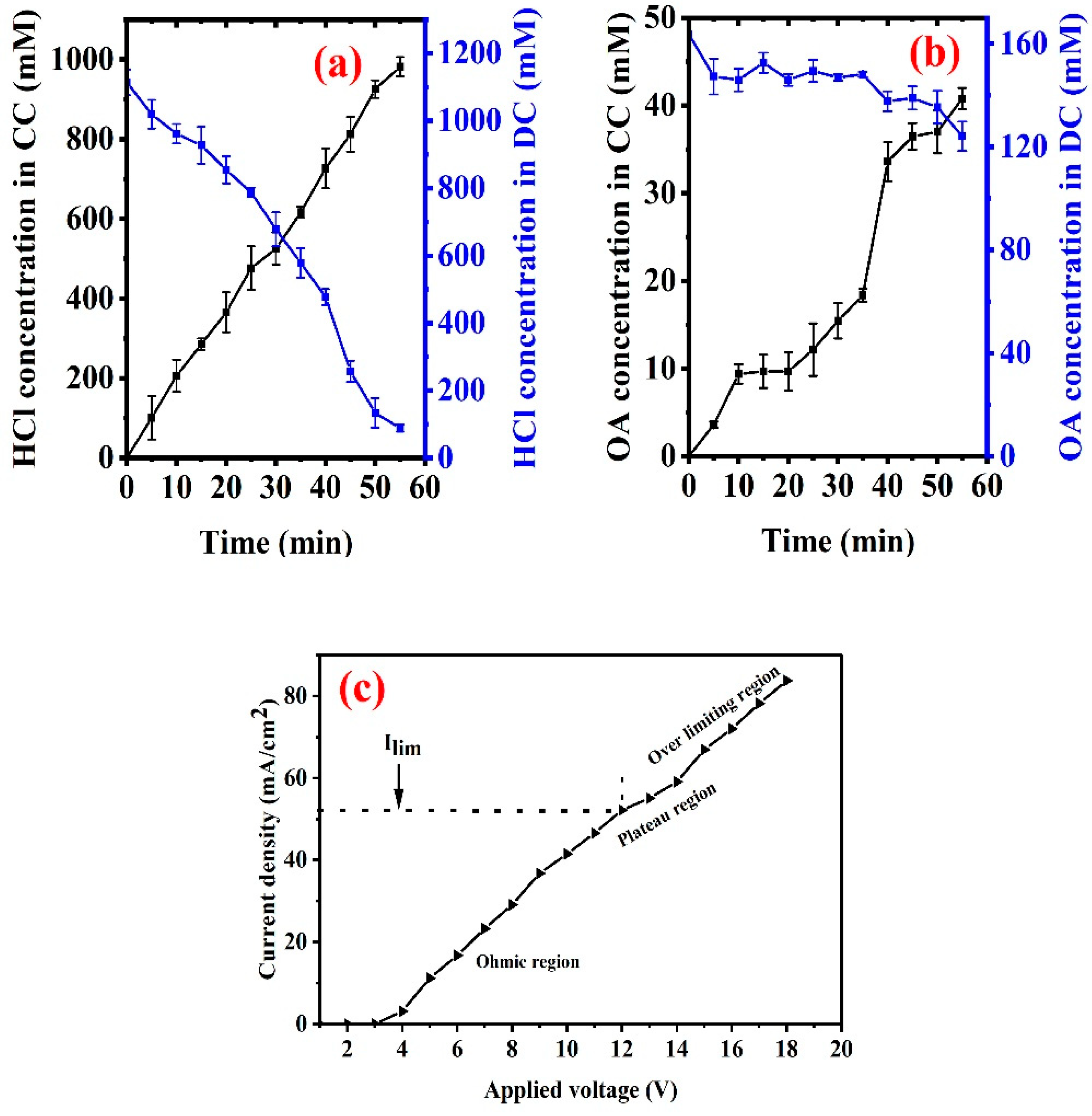
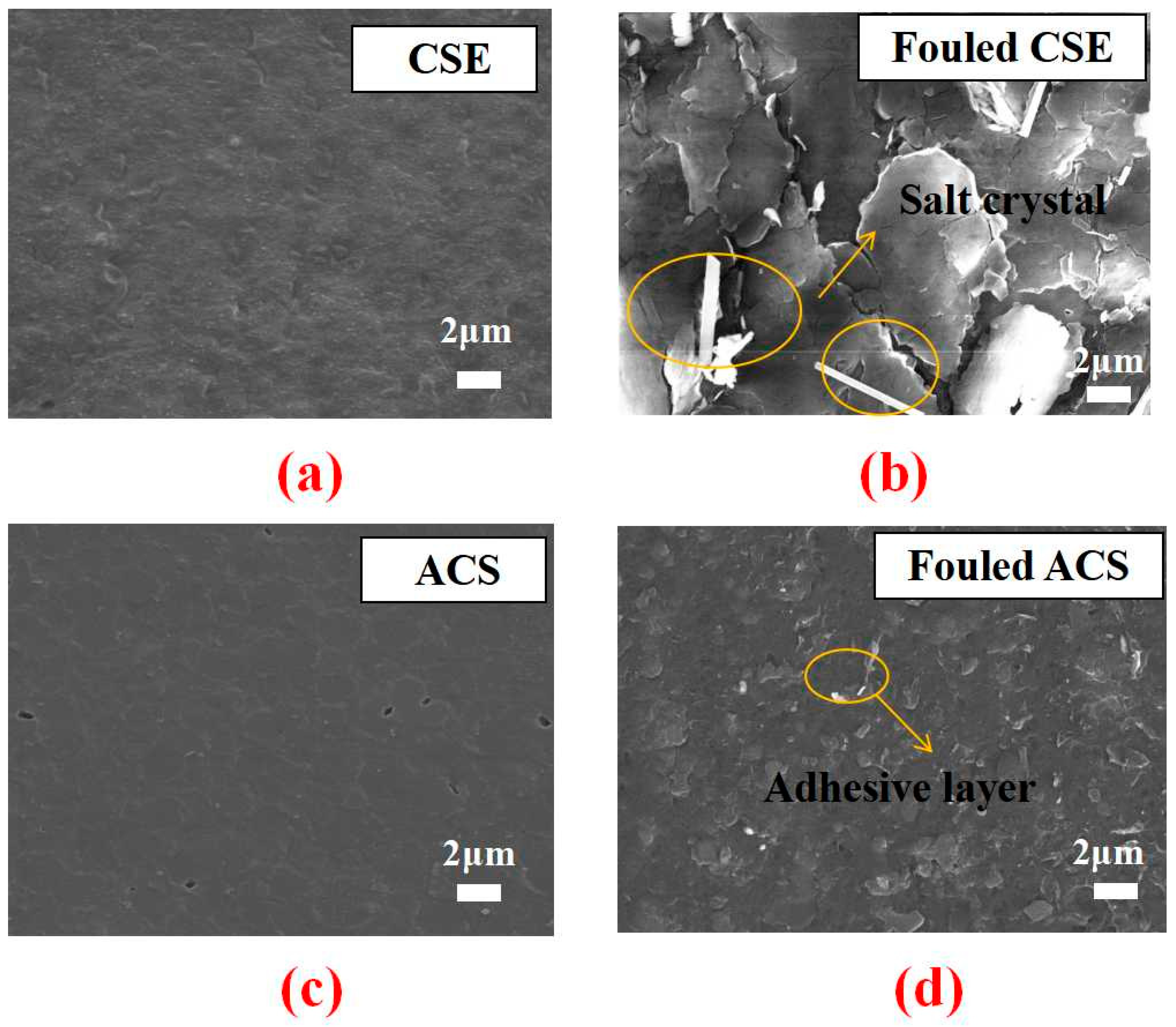
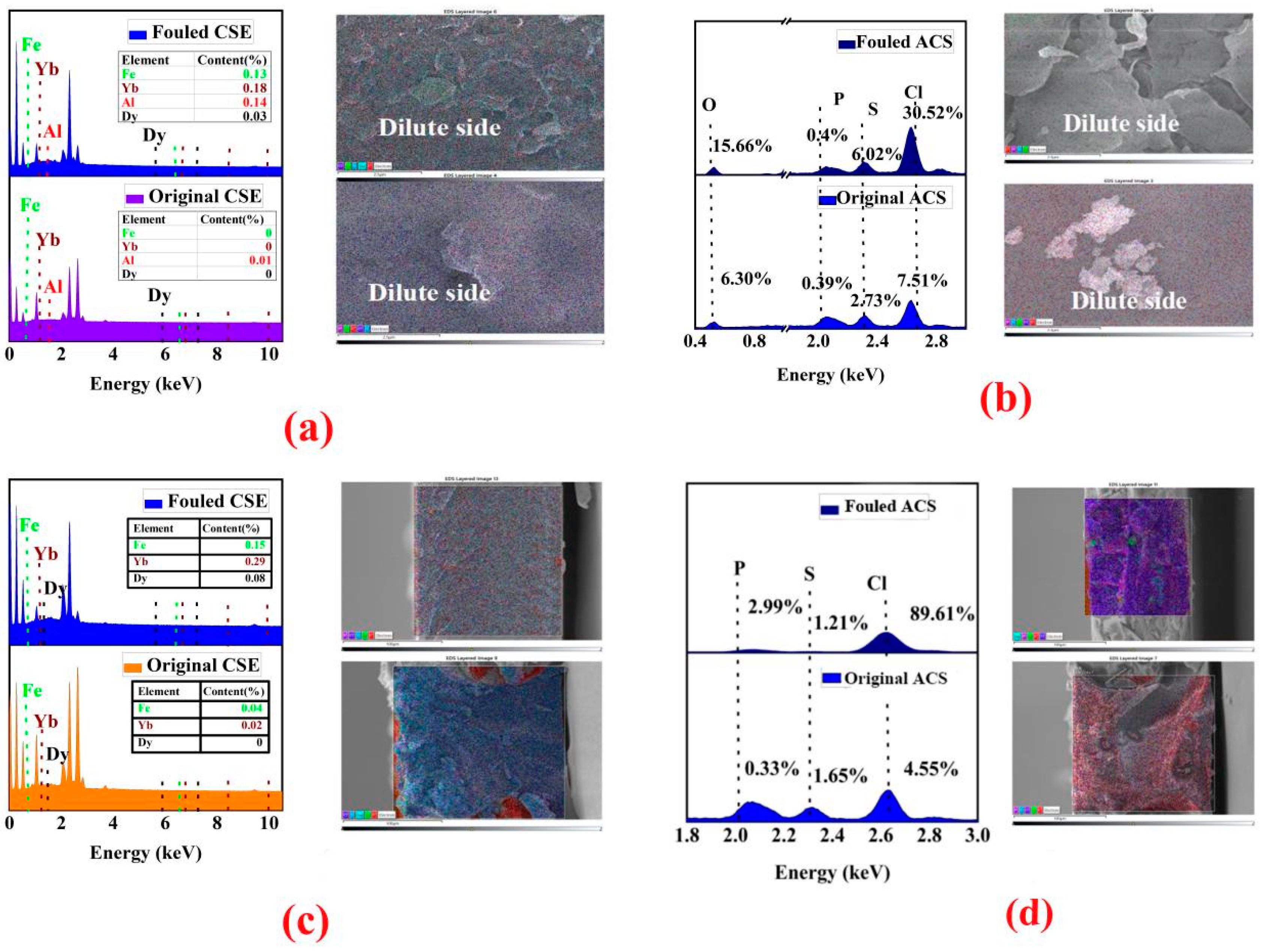
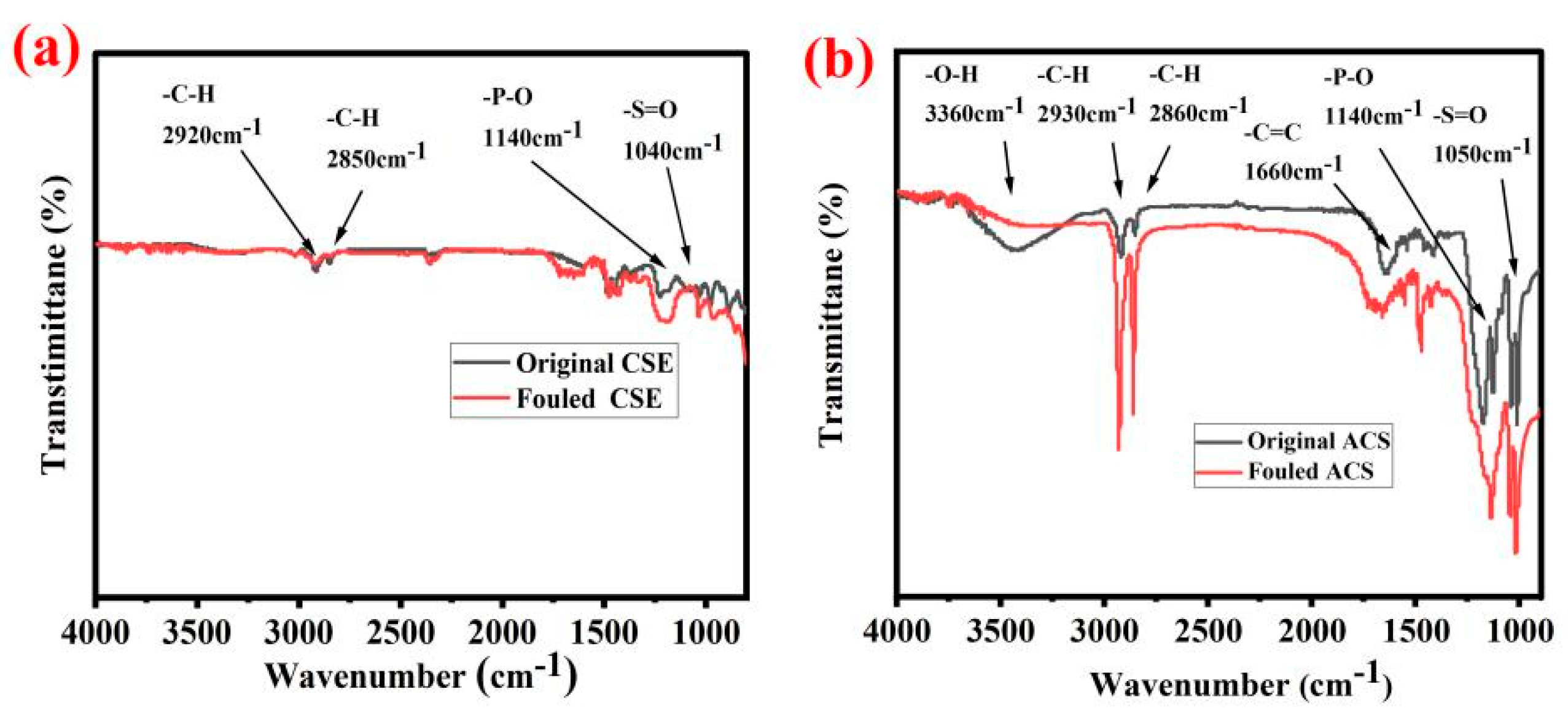
| Parameter | Unit | Ion Exchange Membranes | |||||
|---|---|---|---|---|---|---|---|
| ACS | CSE | AAM | CAM | ATG-10 | CTG-10 | ||
| Thickness 1 | mm | 0.13 | 0.16 | 0.36 | 0.32 | 0.18 | 0.19 |
| Resistance 2 | Ω cm2 | 3.8 | 1.8 | 6 | 7 | 2.3 | 1.9 |
| Bursting strength 3 | MPa | ≥0.15 | ≥0.35 | 0.6 | 0.6 | 1 | 0.5 |
| Using temperature 4 | ℃ | ≤40 | ≤40 | ≤40 | ≤40 | ≤40 | ≤40 |
| Effective Area 5 | m2 | 0.055 | 0.055 | 0.055 | 0.055 | 0.055 | 0.055 |
| pH 6 | -- | 0~8 | 0~14 | 2~12 | 2~12 | 2~10 | 2~10 |
| Water absorption ratio 7 | % | 20.59% | 36.14% | 26.62% | 50.94% | 23.48% | 36.36% |
Disclaimer/Publisher’s Note: The statements, opinions and data contained in all publications are solely those of the individual author(s) and contributor(s) and not of MDPI and/or the editor(s). MDPI and/or the editor(s) disclaim responsibility for any injury to people or property resulting from any ideas, methods, instructions or products referred to in the content. |
© 2023 by the authors. Licensee MDPI, Basel, Switzerland. This article is an open access article distributed under the terms and conditions of the Creative Commons Attribution (CC BY) license (https://creativecommons.org/licenses/by/4.0/).
Share and Cite
Zhou, H.; Ju, P.; Hu, S.; Shi, L.; Yuan, W.; Chen, D.; Wang, Y.; Shi, S. Separation of Hydrochloric Acid and Oxalic Acid from Rare Earth Oxalic Acid Precipitation Mother Liquor by Electrodialysis. Membranes 2023, 13, 162. https://doi.org/10.3390/membranes13020162
Zhou H, Ju P, Hu S, Shi L, Yuan W, Chen D, Wang Y, Shi S. Separation of Hydrochloric Acid and Oxalic Acid from Rare Earth Oxalic Acid Precipitation Mother Liquor by Electrodialysis. Membranes. 2023; 13(2):162. https://doi.org/10.3390/membranes13020162
Chicago/Turabian StyleZhou, Hengcheng, Peihai Ju, Shaowei Hu, Lili Shi, Wenjing Yuan, Dongdong Chen, Yujie Wang, and Shaoyuan Shi. 2023. "Separation of Hydrochloric Acid and Oxalic Acid from Rare Earth Oxalic Acid Precipitation Mother Liquor by Electrodialysis" Membranes 13, no. 2: 162. https://doi.org/10.3390/membranes13020162
APA StyleZhou, H., Ju, P., Hu, S., Shi, L., Yuan, W., Chen, D., Wang, Y., & Shi, S. (2023). Separation of Hydrochloric Acid and Oxalic Acid from Rare Earth Oxalic Acid Precipitation Mother Liquor by Electrodialysis. Membranes, 13(2), 162. https://doi.org/10.3390/membranes13020162






